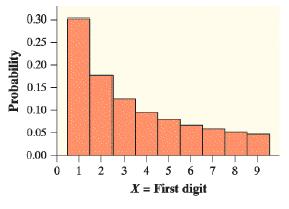Faked numbers in tax returns, invoices, or expense account claims often display patterns that arent present in
Question:
Faked numbers in tax returns, invoices, or expense account claims often display patterns that aren’t present in legitimate records. Some patterns, like too many round numbers, are obvious and easily avoided by a clever crook. Others are more subtle. It is a striking fact that the first digits of numbers in legitimate records often follow a model known as Benford’s law.4 Call the first digit of a randomly chosen legitimate record X for short. The probability distribution for X is shown here (note that a first digit cannot be 0).

a. A histogram of the probability distribution is shown. Describe its shape.
b. Calculate and interpret the expected value of X.

Fantastic news! We've Found the answer you've been seeking!
Step by Step Answer:
Related Book For 

Question Posted:





